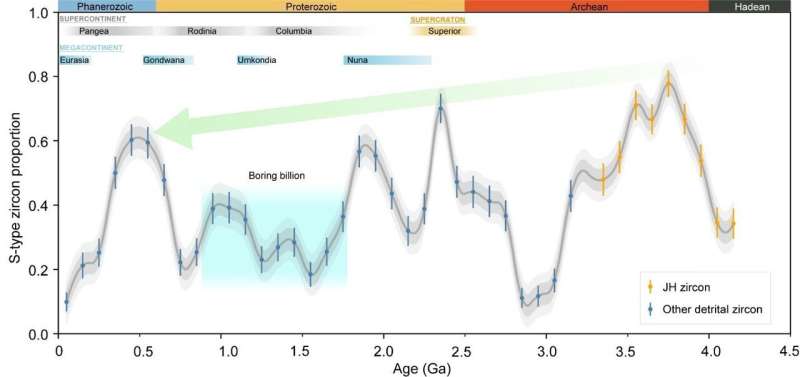
JULY 16, 2024 by Zhang Nannan, Chinese Academy of Sciences
Collected at: https://phys.org/news/2024-07-machine-secrets-early-plate-tectonics.html
Rock weathering and plate tectonics are vital to life. They both regulate the planet’s surface temperature and provide bio-essential nutrients. But how and when these critical processes began on Earth is still a mystery. And is it possible that they may date back to Earth’s infancy—the Hadean Eon, more than four billion years ago?
The central problem is that the Earth doesn’t preserve any rocks of that age, so geologists must rely exclusively on the oldest Hadean materials that are preserved: the Jack Hills zircon from the remote outback of Western Australia. Not surprisingly, the Jack Hills zircon has been both lauded and questioned for containing (or not) potential evidence of Earth’s earliest signs of sediments and plate tectonics.
For years, geologists have tried to determine whether or not the Jack Hills zircon crystallized from a sediment-bearing magma. Granitic magma containing sediments is known as sediment-derived, or “S-type,” granite. But so far, using traditional geochemical proxies, the results have been mixed.
A traditional discrimination diagram using a small handful of trace elements has been used to argue for only rare, or almost no S-type granites on early Earth. At low phosphorus (P) contents, however, the different types of zircon sources unfortunately overlap, which is particularly problematic because low-P zircons make up >95% of the oldest detrital zircons. Clearly, more zircon trace element information is needed.

In a study published in the journal PNAS, a research team led by Prof. Ross Mitchell from the Institute of Geology and Geophysics of the Chinese Academy of Sciences (IGGCAS) has addressed this problem by applying a precise machine learning method to recognize Hadean S-type zircon. This new approach distinguishes S-type zircon from non-S-type zircon, especially with the ability to identify low-P S-type zircon in the Hadean.
While previous work argues for rare S-type granites on early Earth, this is the first study to suggest the abundant presence of Hadean S-type zircon. With a much higher accuracy of 96%, they demonstrated not only the existence, but the abundance of Jack Hills S-type zircon, dating as far back as 4.24 billion years ago.
“This means that crustal weathering, deposition of sedimentary rocks, and their burial and incorporation into magma sources may have begun more than 4 billion years ago,” said Mitchell.
The machine-learning-identified changes in the Hadean S-type granites are consistent with other geochemical features, such as Hf isotope cycling and elevated δ18O values, consistently indicating a connection with continental collision and mountain building.

By further classifying global detrital zircon throughout all geologic time, they found that such high peaks of S-type zircon proportions have occurred repeatedly since 4 billion years ago. Surprisingly, they found that these peaks are consistent with the formation of supercontinents.
“It looks like a cycle, with a strikingly similar ~600 million year period to the supercontinent cycle. When the continents of the world collide, the amount of S-type zircon increases, and then decreases during the breakup,” said Jiang Jilian, first author of the study.
This consistent pattern through time suggests that the process of plates moving and colliding, driven by subduction, has been going on almost since the earliest days of the Earth. This means that subduction-driven plate tectonics has been operating since the Hadean.
“S-type granites kill two birds with one stone, by being a signature of both surface weathering (to generate the sediments) and plate subduction (to produce the sediments into magma chambers),” said Mitchell. “With these two processes essentially in place from day one, the Hadean Earth would have been habitable, allowing for the origin of life not only at hydrothermal vents, but also in Darwin’s warm pools.”

Bruce Watson, a geochemist at the Rensselaer Polytechnic Institute who did some of the seminal work on the Jack Hills zircon and was not involved in the study, said, “The authors introduce a new strategy with their machine-learning approach that should set the stage (and a standard) for future work on early Earth zircons.”
This study demonstrates the potential of machine learning to explore and uncover knowledge that had previously been elusive using traditional methods. Further studies using AI-based knowledge mining should provide new insights into the Earth’s ancient history in the future.
More information: Jilian Jiang et al, Sediment subduction in Hadean revealed by machine learning, Proceedings of the National Academy of Sciences (2024). DOI: 10.1073/pnas.2405160121
Journal information: Proceedings of the National Academy of Sciences

Leave a Reply